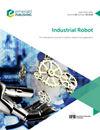Robotic direct grinding for unknown workpiece contour based on adaptive constant force control and human-robot collaboration
IF 2.5
4区 计算机科学
Q3 ENGINEERING, INDUSTRIAL
Industrial Robot-The International Journal of Robotics Research and Application
Pub Date : 2022-10-03
DOI:10.1108/ir-01-2022-0021
引用次数: 2
Abstract
Purpose In customized production such as plate workpiece grinding, because of the diversity of the workpiece shapes and the positional/orientational clamping errors, great efforts are taken to repeatedly calibrate and program the robots. To change this situation, the purpose of this study is to propose a method of robotic direct grinding for unknown workpiece contour based on adaptive constant force control and human–robot collaboration. Design/methodology/approach First, an adaptive constant force controller based on stiffness estimation is proposed, which can distinguish the contact of the human hand and the unknown workpiece contour. Second, a normal vector search algorithm is developed to calculate the normal vector of the unknown workpiece contour in real-time. Finally, the force and position are controlled in the calculated normal and tangential directions to realize the direct grinding. Findings The method considers the disturbance of the tangential grinding force and the friction, so the robot can track and grind the workpiece contour simultaneously. The experiments prove that the method can ensure the force error and the normal vector calculating error within 0.3 N and 4°. This human–robot collaboration pattern improves the convenience of the grinding process. Research limitations/implications The proposed method realizes constant force grinding of unknown workpiece contour in real-time and ensures the grinding consistency. In addition, combined with human–robot collaboration, the method saves the time spent in repeated calibration and programming. Originality/value Compared with other related research, this method has better accuracy and anti-disturbance capability of force control and normal vector calculation during the actual grinding process.基于自适应恒力控制和人机协作的未知工件轮廓机器人直接磨削
目的在板材磨削等定制生产中,由于工件形状的多样性和位置/方向夹持误差,需要花费大量精力对机器人进行反复校准和编程。为了改变这一现状,本研究提出了一种基于自适应恒力控制和人机协作的未知工件轮廓机器人直接磨削方法。设计/方法/方法首先,提出了一种基于刚度估计的自适应恒力控制器,该控制器可以区分人手接触和未知工件轮廓;其次,提出了一种法向量搜索算法,用于实时计算未知工件轮廓的法向量;最后将力和位置控制在计算的法向和切向上,实现直接磨削。研究结果:该方法考虑了切向磨削力和摩擦的干扰,使机器人能够同时跟踪和磨削工件轮廓。实验证明,该方法能保证力误差和法向量计算误差在0.3 N和4°以内。这种人机协作模式提高了磨削过程的便利性。研究局限/启示提出的方法实现了对未知工件轮廓的恒力实时磨削,并保证了磨削一致性。此外,结合人机协作,该方法节省了反复校准和编程的时间。与其他相关研究相比,该方法在实际磨削过程中的力控制和法向量计算具有更好的精度和抗干扰能力。
本文章由计算机程序翻译,如有差异,请以英文原文为准。
求助全文
约1分钟内获得全文
求助全文
来源期刊
CiteScore
4.50
自引率
16.70%
发文量
86
审稿时长
5.7 months
期刊介绍:
Industrial Robot publishes peer reviewed research articles, technology reviews and specially commissioned case studies. Each issue includes high quality content covering all aspects of robotic technology, and reflecting the most interesting and strategically important research and development activities from around the world.
The journal’s policy of not publishing work that has only been tested in simulation means that only the very best and most practical research articles are included. This ensures that the material that is published has real relevance and value for commercial manufacturing and research organizations. Industrial Robot''s coverage includes, but is not restricted to:
Automatic assembly
Flexible manufacturing
Programming optimisation
Simulation and offline programming
Service robots
Autonomous robots
Swarm intelligence
Humanoid robots
Prosthetics and exoskeletons
Machine intelligence
Military robots
Underwater and aerial robots
Cooperative robots
Flexible grippers and tactile sensing
Robot vision
Teleoperation
Mobile robots
Search and rescue robots
Robot welding
Collision avoidance
Robotic machining
Surgical robots
Call for Papers 2020
AI for Autonomous Unmanned Systems
Agricultural Robot
Brain-Computer Interfaces for Human-Robot Interaction
Cooperative Robots
Robots for Environmental Monitoring
Rehabilitation Robots
Wearable Robotics/Exoskeletons.

 求助内容:
求助内容: 应助结果提醒方式:
应助结果提醒方式:


